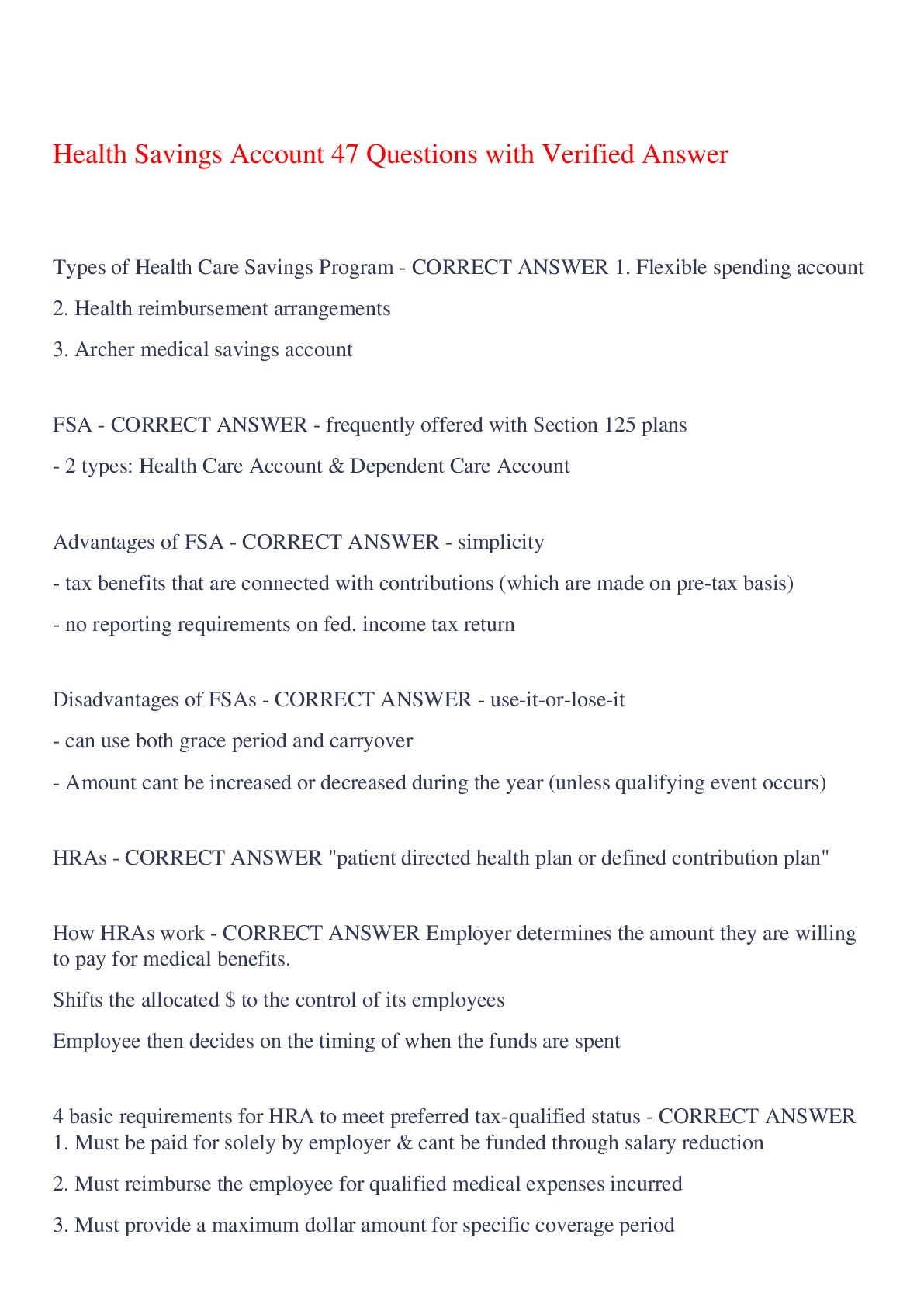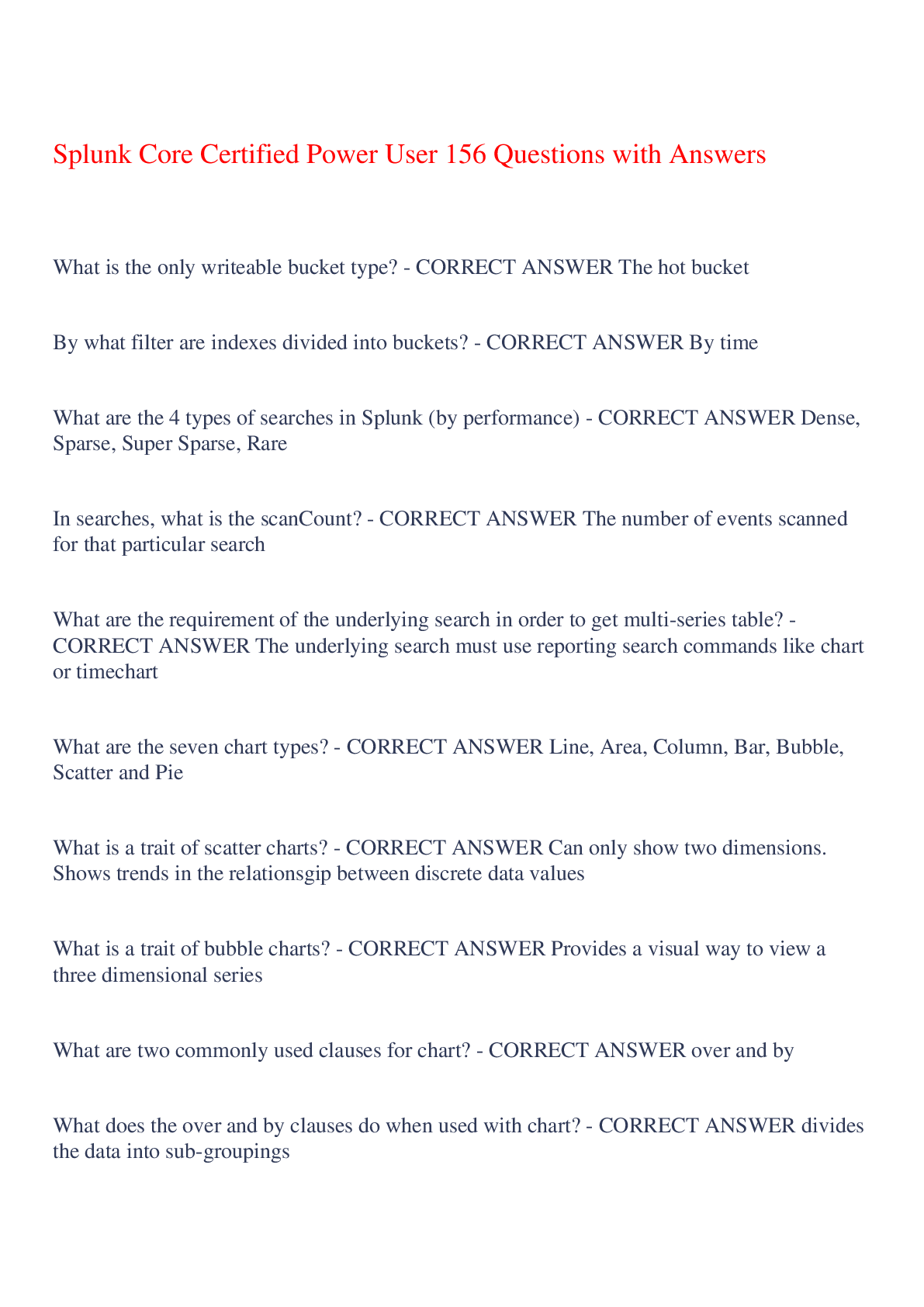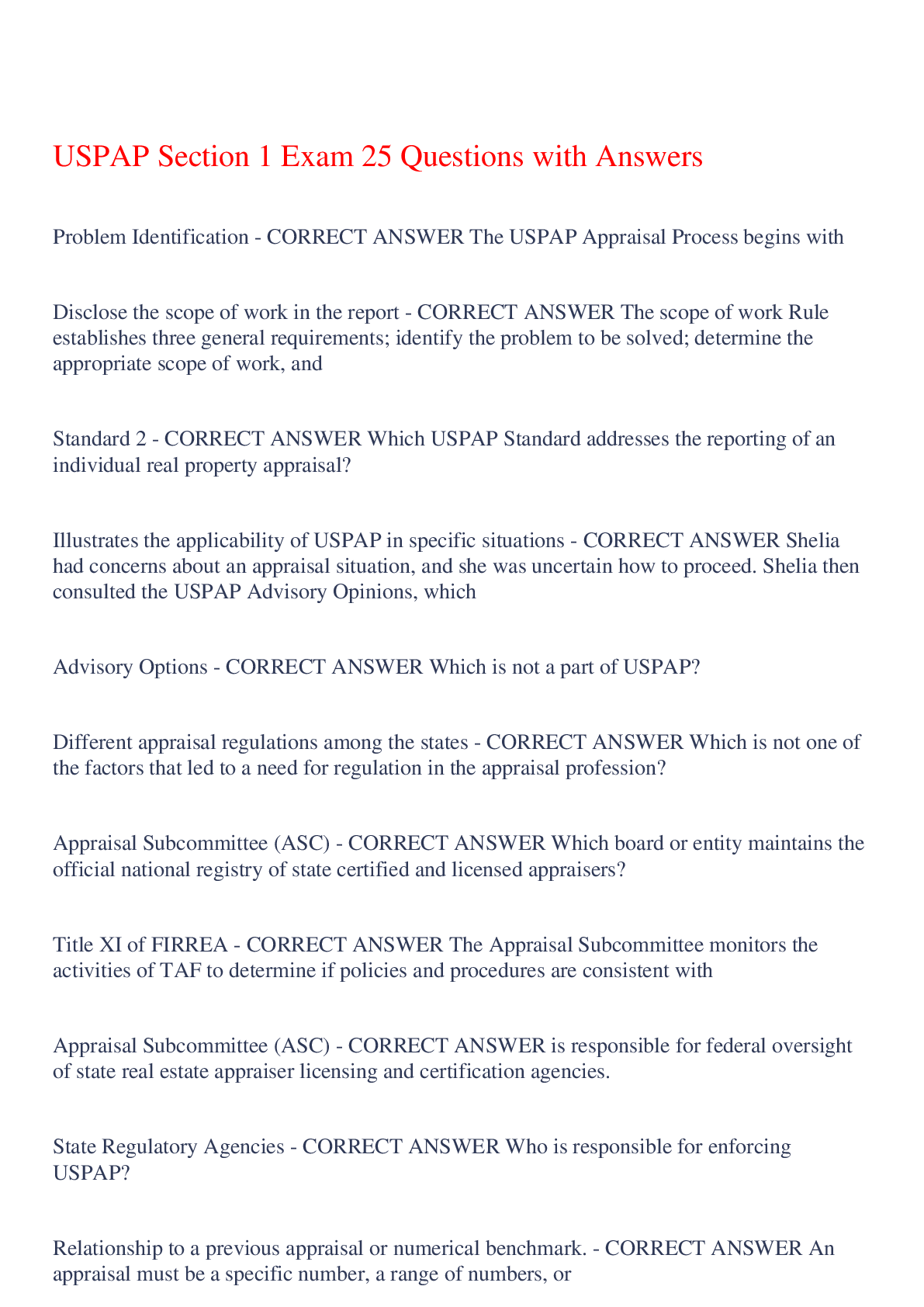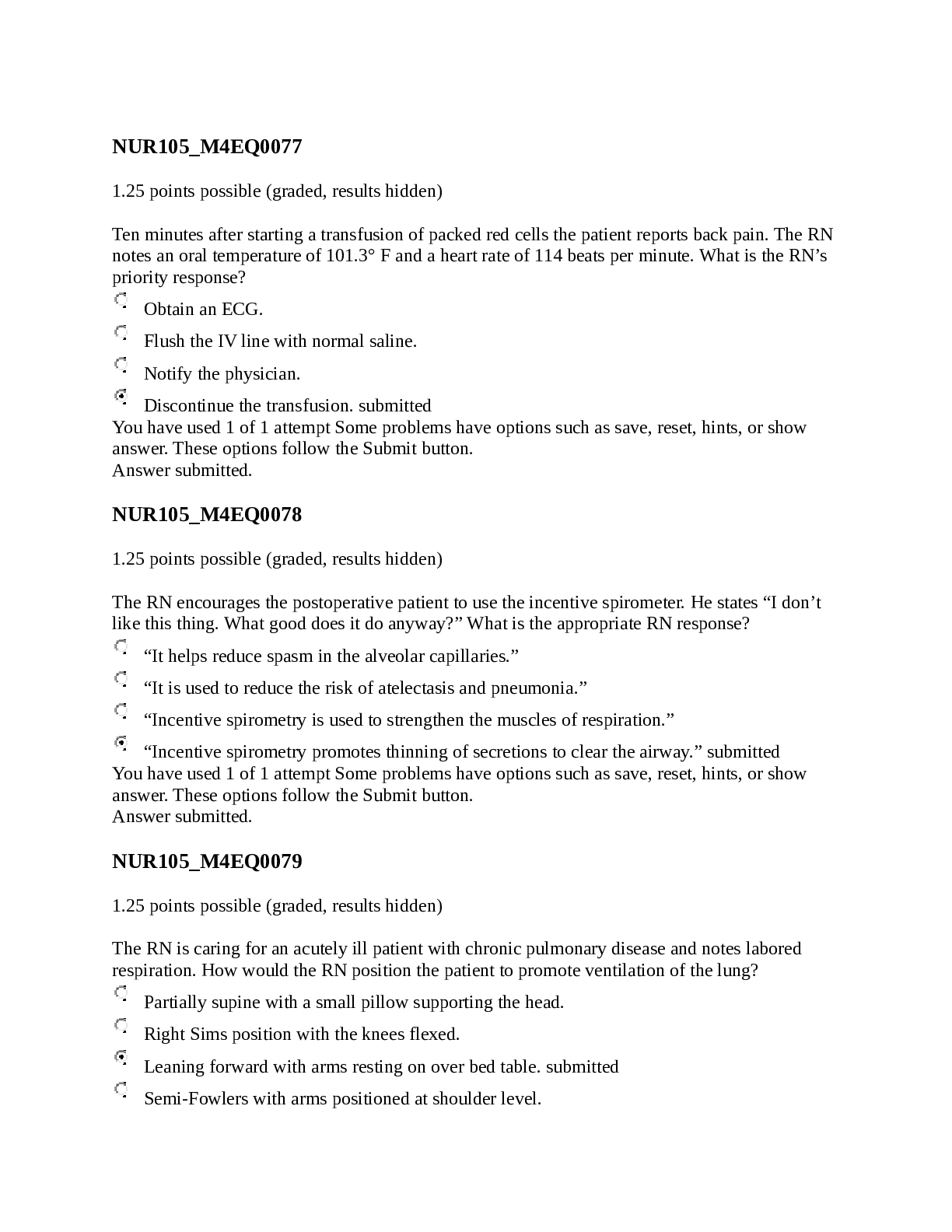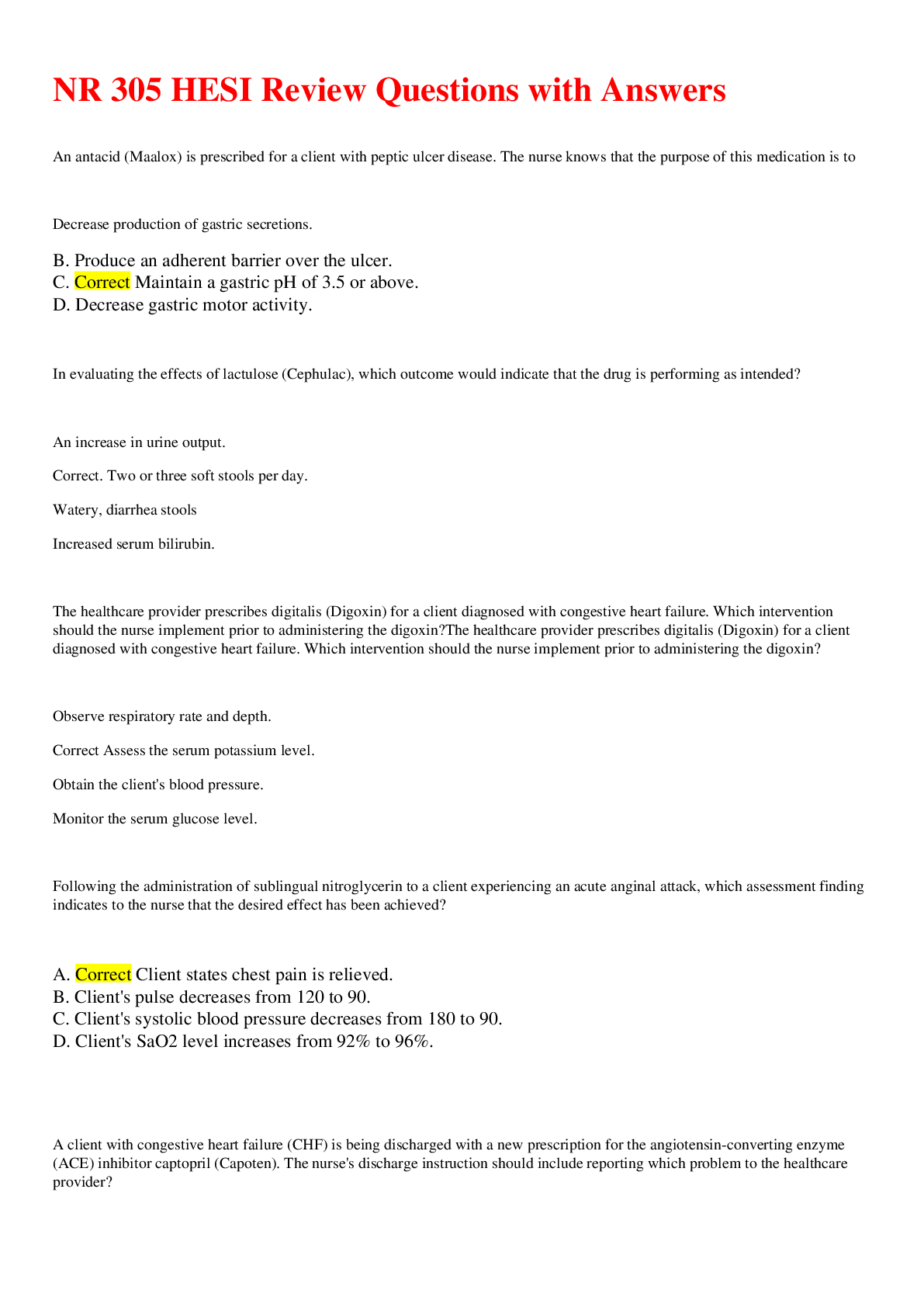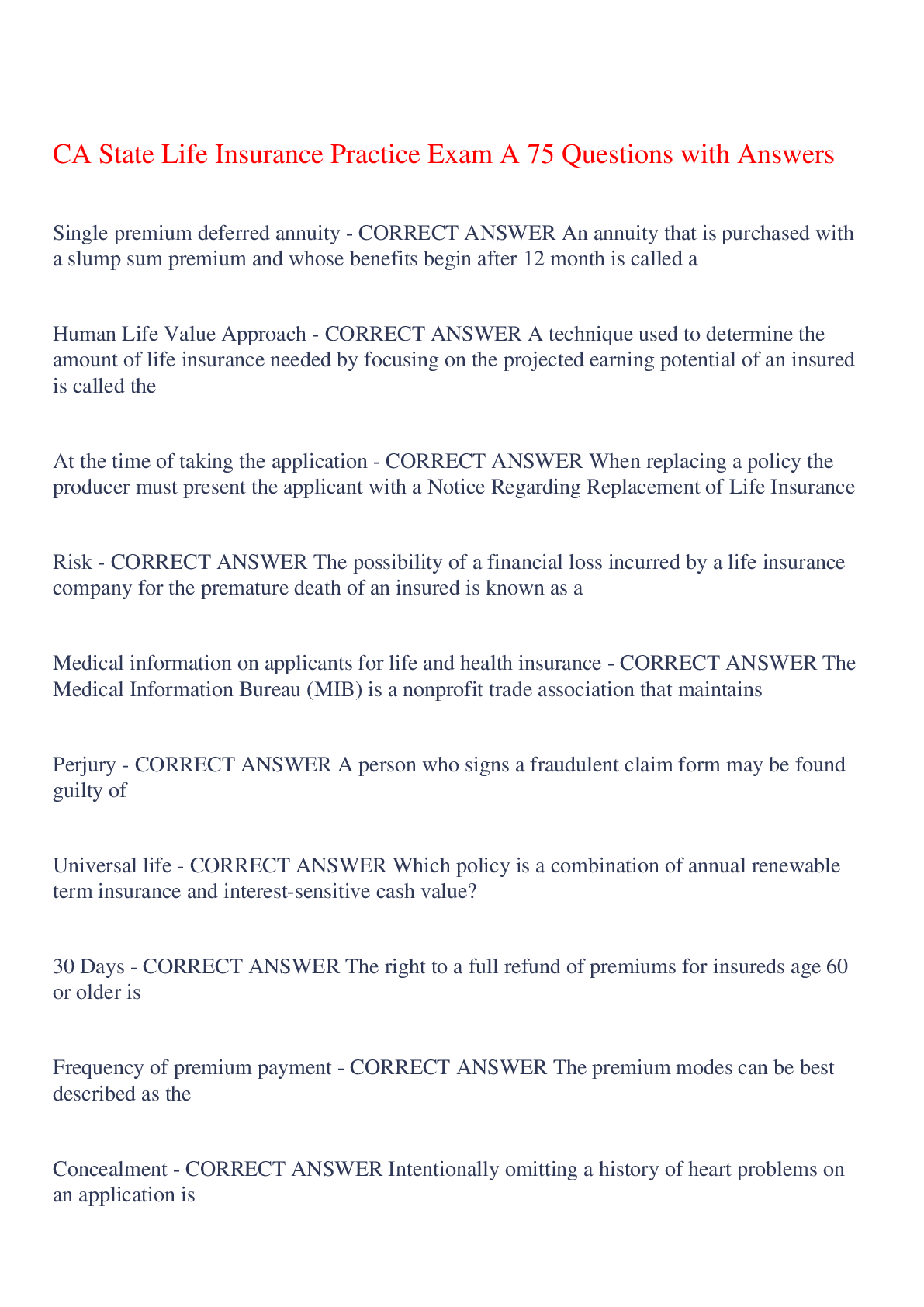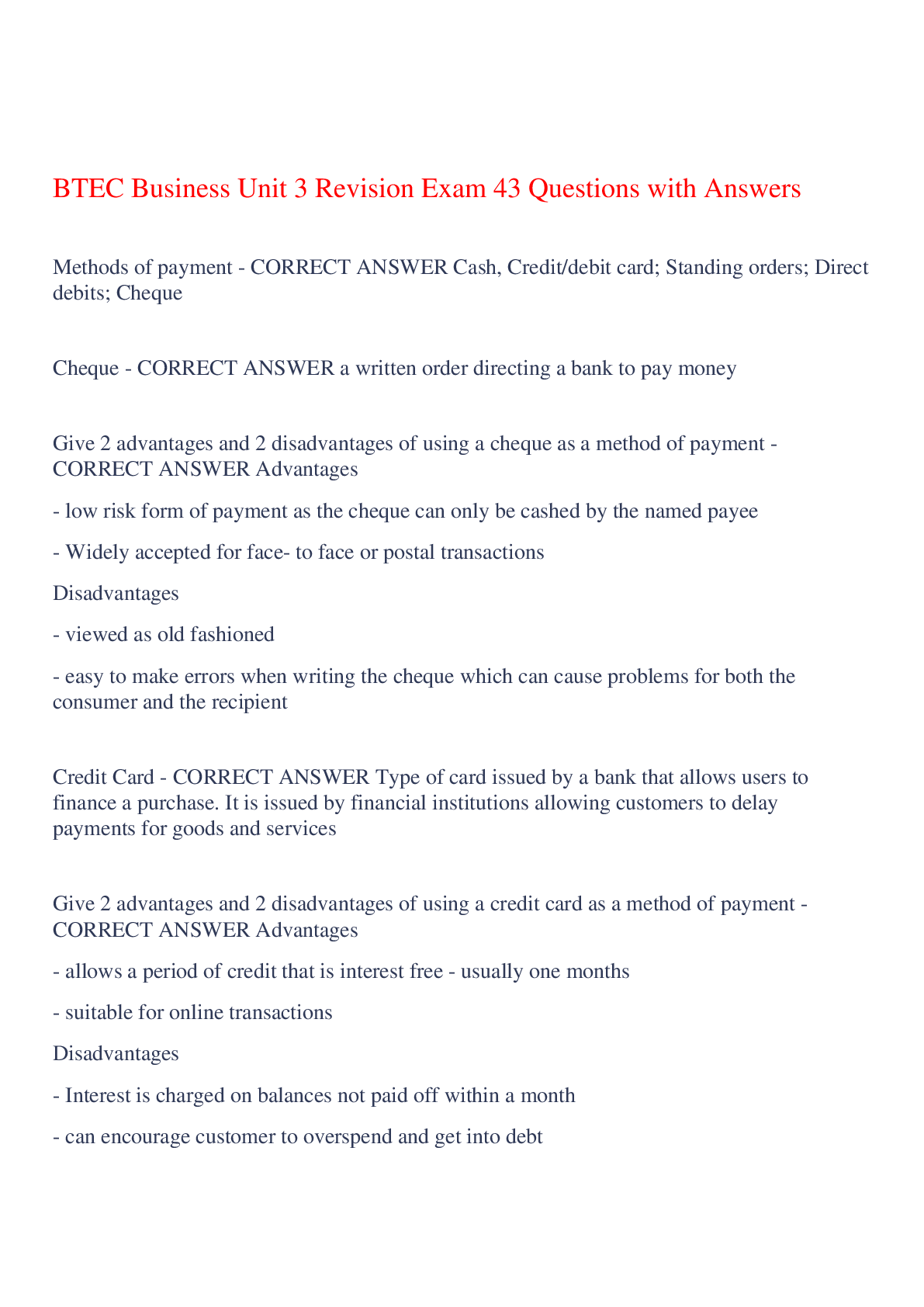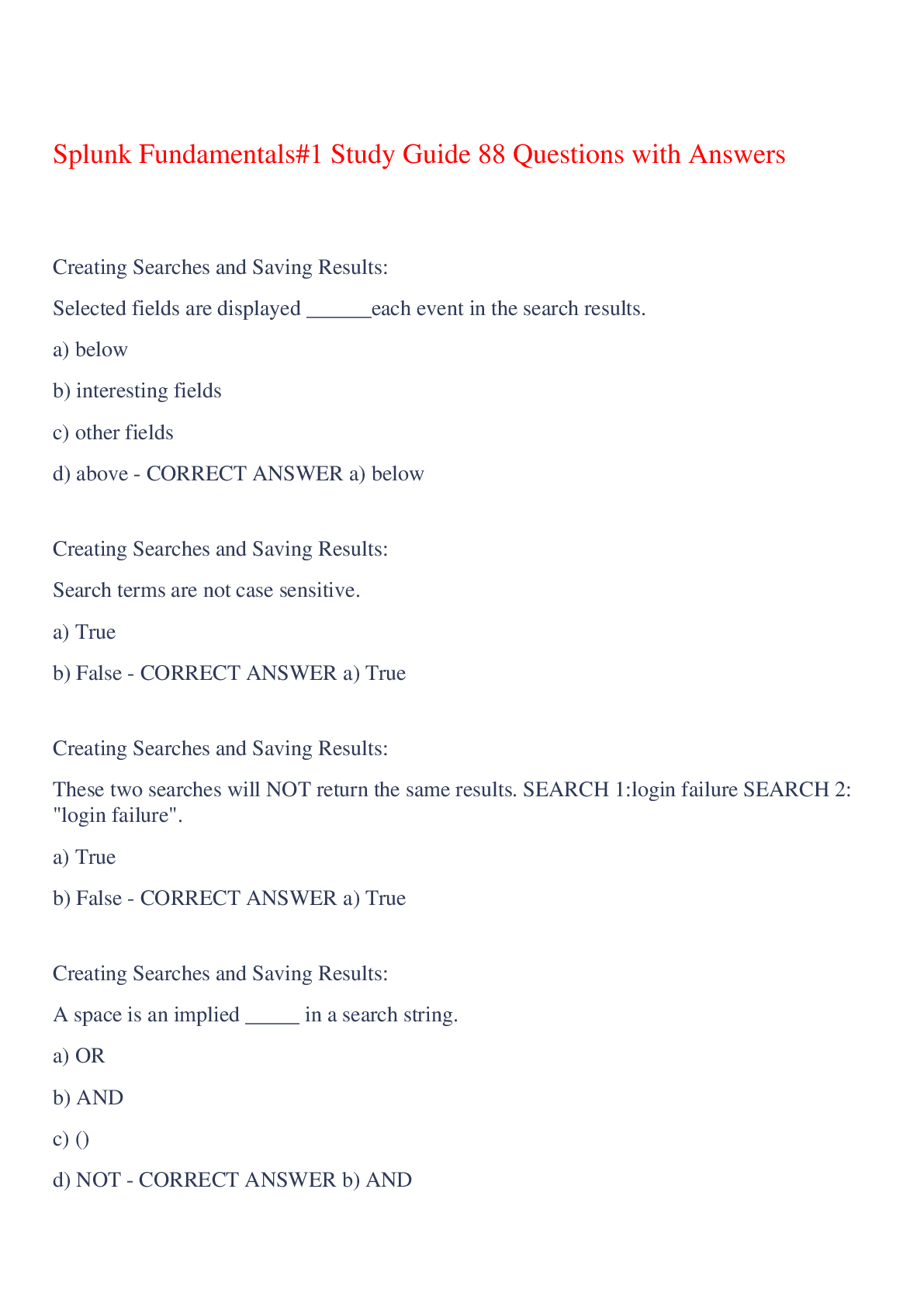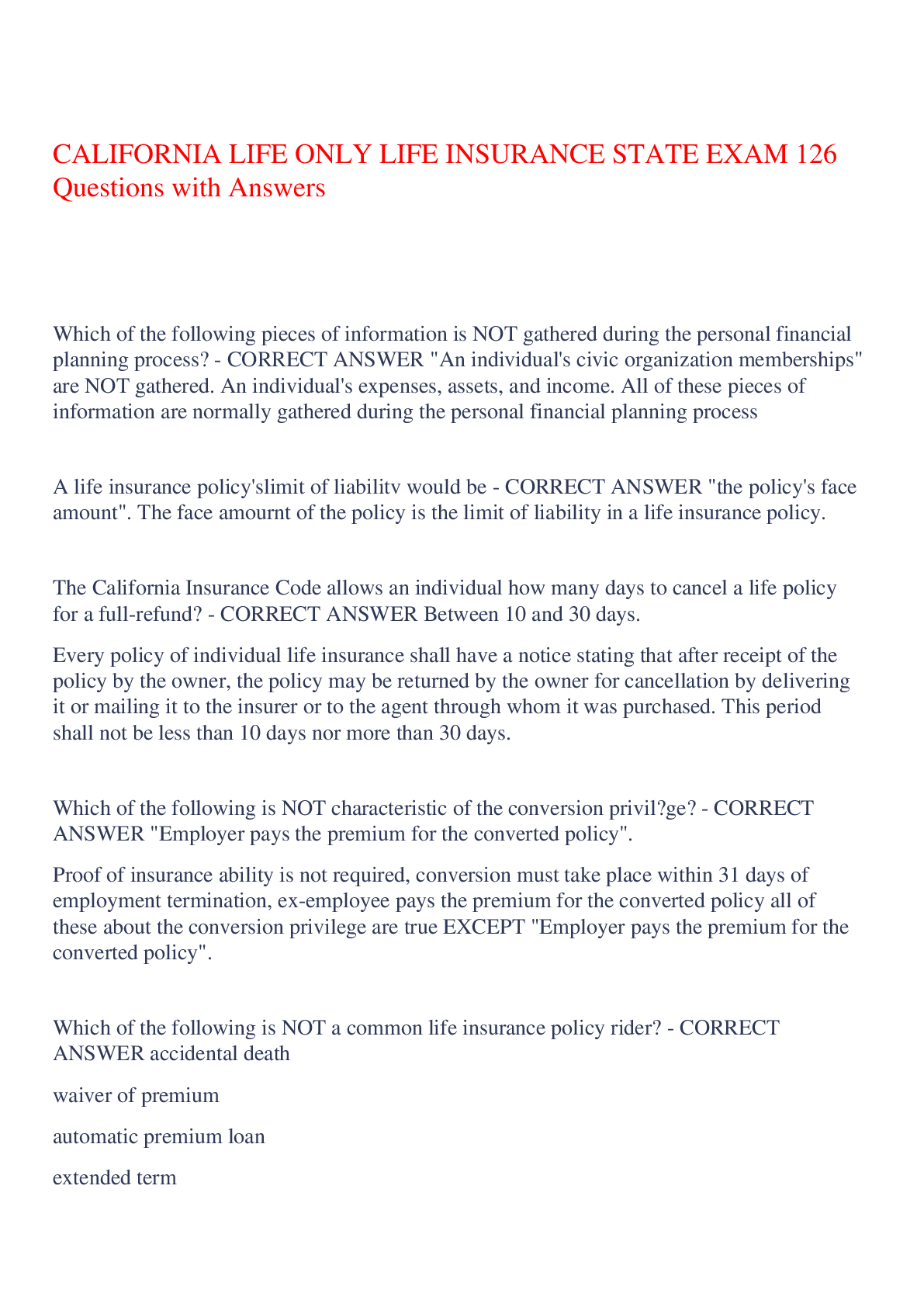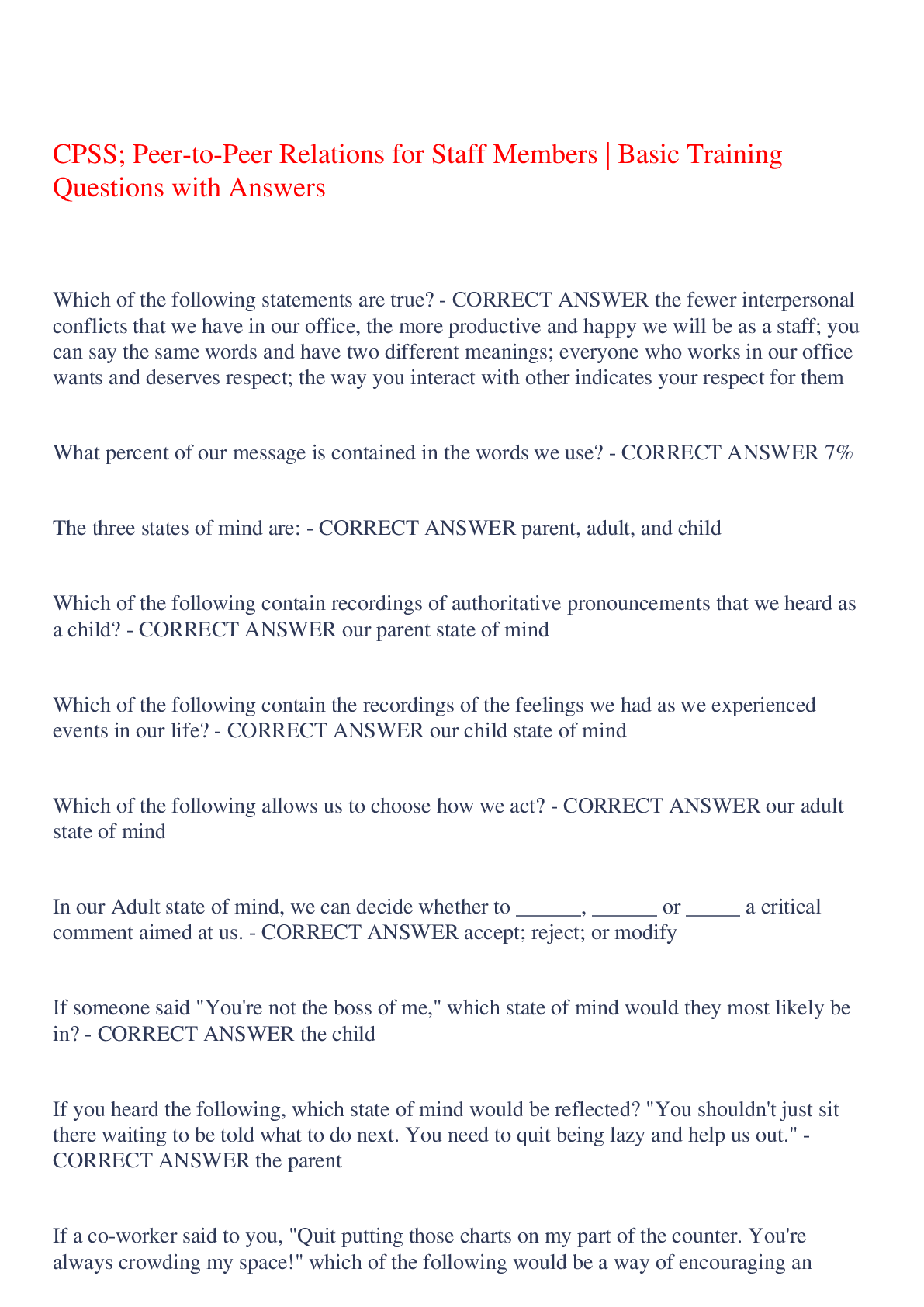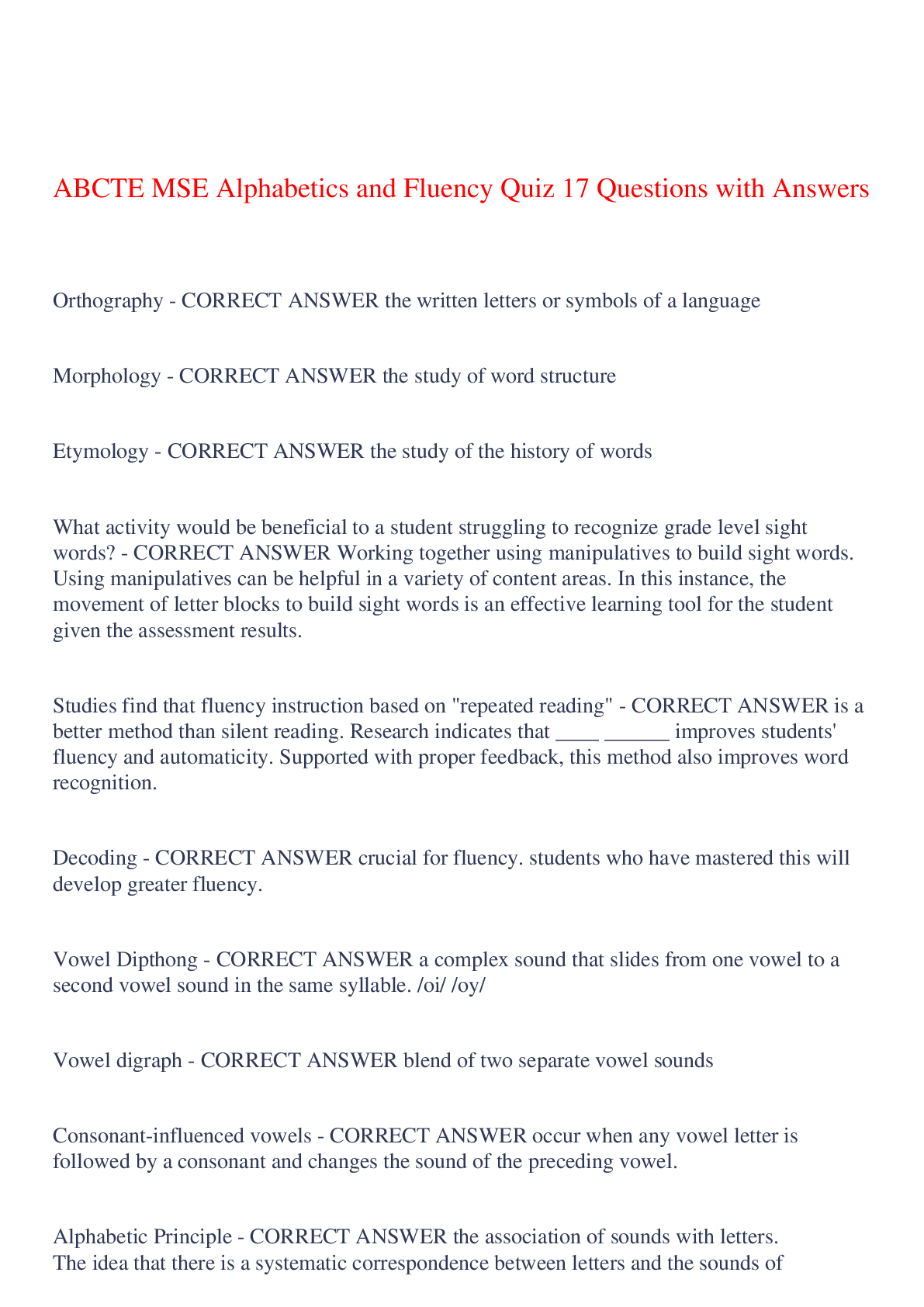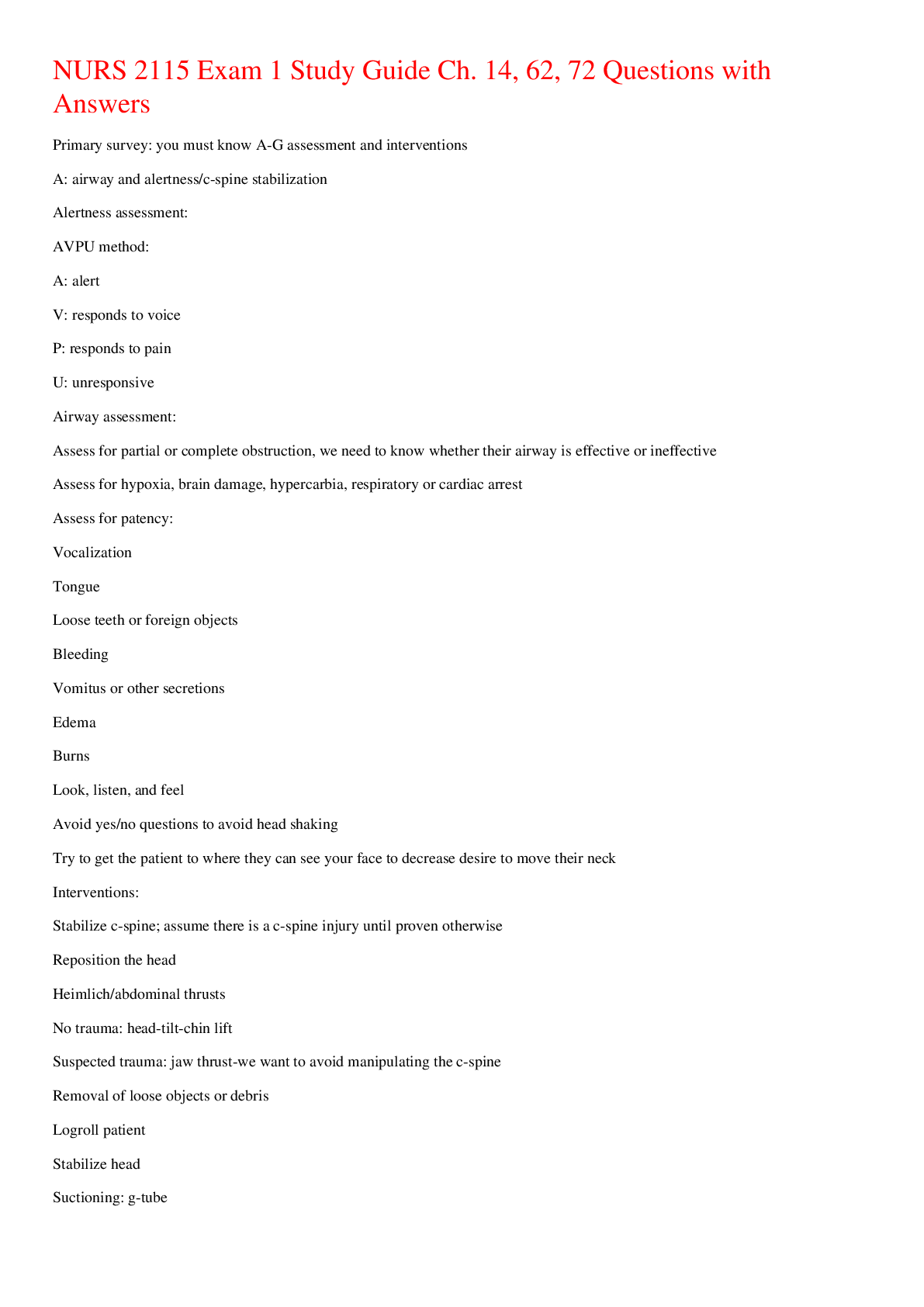Early Childhood Education Exam 1|57 Questions with Answers,100% CORRECT
Document Content and Description Below
Early Childhood Education Exam 1|57 Questions with Answers DAP - CORRECT ANSWER development appropriate practices early childhood education - CORRECT ANSWER high personal standards, expands his ... or hers skill and knowledge 6 standards for professional development - CORRECT ANSWER 1. promoting child development and learning 2. building family and community relationships 3. observing, documenting, assessing to support children and families 4. using developmentally effective approaches to connect with children and families 5. using content knowledge to build meaningful curriculum 6. becoming a professional 4 types of knowledge - CORRECT ANSWER procedural, conceptual, implications, reflective practice - CORRECT ANSWER having children talk about what they have done during the day so they can fully understand what the learned caring - CORRECT ANSWER you will lose sleep trying to find a way to help a child learn to read and you will spend long hours planning and gathering materials professional dispositions - CORRECT ANSWER your, value, commitments, attitudes, professional growth, professional ethics collaborative planning - CORRECT ANSWER teachers coming together to plan curriculum philosophy of education - CORRECT ANSWER a set of belief about how children develop and learn and what and how they should be taught guidelines: read, reflect, discuss, write and share, and evaluate inclusive environment - CORRECT ANSWER for children with special needs by implementing necessary adaptations, create high expectations so child will reach full potential, establish support and services poverty - CORRECT ANSWER low income families, female headed families, poor school achievement, children are most likely to drop out achievement gaps - CORRECT ANSWER parents of poverty spend less time working with children on school work which can put them behind teenage birth rates - CORRECT ANSWER decline but however on the rise again, most common places are south and southwest states, Mississippi, Texas, New Mexico, least common New Hampshire, Massachusetts, Vermont leading childhood diseases - CORRECT ANSWER asthma, lead poisoning, and obesity divorce rates - CORRECT ANSWER 35% of marriages cultural competency - CORRECT ANSWER set of congruent behaviors, attitudes, and polices that come together in a system single parents - CORRECT ANSWER continous to increase, reasons for this 35% of all marriages end in divorce, parents by default, more women have children without marring ELL's - CORRECT ANSWER english language learners define assessment - CORRECT ANSWER is ongoing, continuous process of collecting, gathering, and documenting information about childrens development, learning, health, behavior, academic progress, need of special services and attainment to make decisions methods of authentic assessment - CORRECT ANSWER refers to the manner in which formative assessments occur, authentic indicates that the assessment is taking place during the actual learning instructional activities in which they are involved screening - CORRECT ANSWER example eye and listening tests, or one on one test such as reading a writing with teacher sheltered instructions - CORRECT ANSWER group projects, group activities, group discussions, labeling, utilizing memorization reaction, teach creative and thinking and problem solving portfolio - CORRECT ANSWER a folder where teachers and students can maintain information and grades on children anecdotal record - CORRECT ANSWER teacher observations that are continuously ongoing and being taking at all times but small notes blank tablet - CORRECT ANSWER presupposes on innate genetic code on inborn traits exists and the sum of of what a child become depends on the nature and quality of experiences types of assessment - CORRECT ANSWER 1. observation 2. anecdotal records 3. running record 4. work sample 5. portfolio 6. interview(blooms taxonomy) 7. rubric 8. event sampling 9. time sampling 10. rating scale 11. checklist blooms taxonomy - CORRECT ANSWER a classification of different of objectives that educators set for students in 3 domains: affective, psychomotor, and cognitive, learning at high level you must have mastered the foundational skills of the lower level rebirth of ideas - CORRECT ANSWER good practices persist over time and are recycled poesy v. ferguson - CORRECT ANSWER court ruling that established "separate but equal" doctrine, which determined that so long as the opportunities and accommodations were equal both races that separating people in public places including schools, was lawful brown v. board of education - CORRECT ANSWER separation of children in public schools solely on the basis of race deprives children of the minority groups of equal educational opportunity blank tablet, tabula rasa - CORRECT ANSWER an absence of preconceived ideas or predetermined goals; clean slate famous individuals - CORRECT ANSWER 7 views of children through the ages - CORRECT ANSWER 1. miniature adults 2. sinful 3. blank tablet 4. growing plants 5. property 6. persons rights 7. investments manipulatives - CORRECT ANSWER things children can use to learn math allowing them to change it in their own way to have a better understanding unfolding - CORRECT ANSWER the reveal gradually by written or spoken explanation theory - CORRECT ANSWER is a set of explanations of how children develop and learn assimilation - CORRECT ANSWER process of fitting new information into existing schemes (knowledge) accommodation - CORRECT ANSWER changing or altering existing schemes or creating new ones in response to new information jean piaget - CORRECT ANSWER the theory of cognitive development, explains how children think, understand, and learn, teachers build on past experience and knowledge, active learning, adaptation, schemes howard gardner - CORRECT ANSWER his theory proposes that children are smart in many ways and he identified 9 different ways theory of multiple intelligences - CORRECT ANSWER 1.visual/ spatial 2. verbal/ linguistic 3. mathematical/ logical 4. bodily/ kinetic 5. musical/ rhythmic 6. intrapersonal 7. interpersonal 8. naturalistic 9. existential piagets stages of intellectual development - CORRECT ANSWER 1. sensorimotor 2. preoperational 3. concrete operations lev vygotsky - CORRECT ANSWER a range of tasks that are too difficult to master alone but that can be learned with guidance and assistance, social interactions, scaffolding ZPD - CORRECT ANSWER zone of proximal development-a range of tasks that are too difficult to master alone but that can be learned with guidance and assistance abraham maslows hierarchy of needs - CORRECT ANSWER everyone has basic needs, these needs must be met by self-fulfillment 1. life essentials 2. safety and security 3. belonging and love 4. achievement and prestige 5. aesthetic needs self-actualization - CORRECT ANSWER the realization or fulfillment of ones talents or potential constructivism - CORRECT ANSWER is the theory that emphasizes the active role of children in developing their own understanding and learning constructive classroom - CORRECT ANSWER physically and mentally active, initiate learning activities, dialogues and conversations, teachers create and support childrens social interactions erik ericksons stages - CORRECT ANSWER 1. basic trust v. mistrust 2. autonomy v. shame and doubt 3. initiative v. guilt 4. industry v. inferiority albert bandura - CORRECT ANSWER social learning theory, children learn through: modeling, observations, vicarious experiences, self-regulation reggio emilia - CORRECT ANSWER program designed for 3 months to 6 years, cooperation, documentation, curriculum is not established in advance, teachers are partners in learning atelierista - CORRECT ANSWER a teacher with an art background active learning - CORRECT ANSWER children using concrete, manipulative material in order to learn concepts, knowledge and skills hundred languages - CORRECT ANSWER children are encourages to express themselves in many ways, words, expression, movement, drawing, painting, sculpting, play, collage, and music montessori's sensory learning objects - CORRECT ANSWER integrates curriculum, active learning, individualized instructions, independence, appropriate assessment, developmentally appropriate practices montessoris 5 basic principles - CORRECT ANSWER 1. respect for the child 2. the absorbent mind 3. sensitive period 4. prepared environment 5. auto-education high scopes daily routine - CORRECT ANSWER planning, work time, recall, small group, large group, outside time, transitions and cleaning up [Show More]
Last updated: 11 months ago
Preview 1 out of 5 pages

Reviews( 0 )
Document information
Connected school, study & course
About the document
Uploaded On
May 19, 2023
Number of pages
5
Written in
Additional information
This document has been written for:
Uploaded
May 19, 2023
Downloads
0
Views
10














